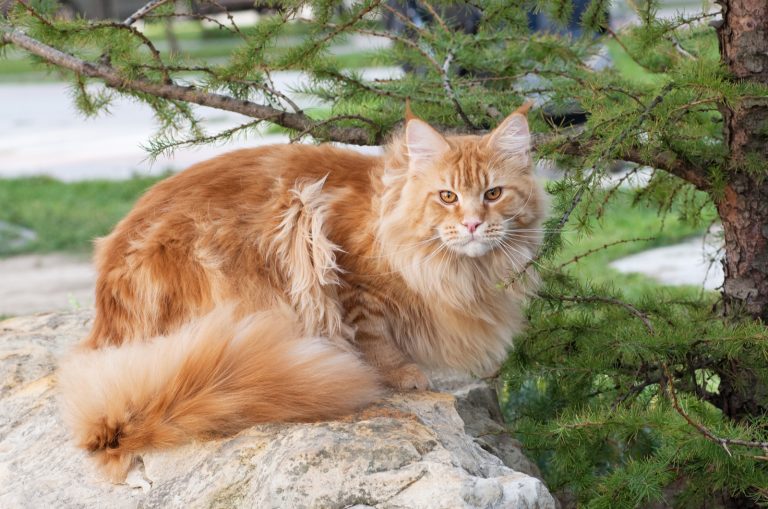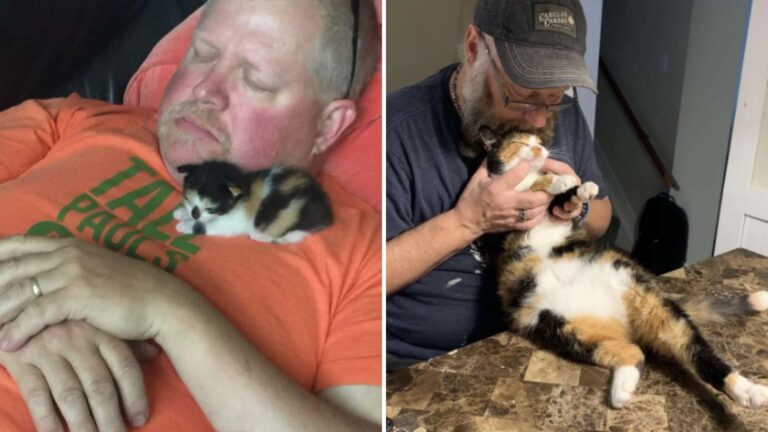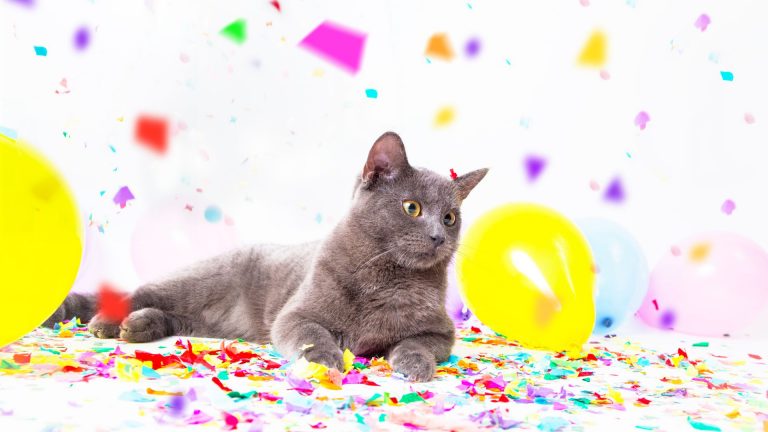How To Know When A Cat Is Done Giving Birth: 7 Signs
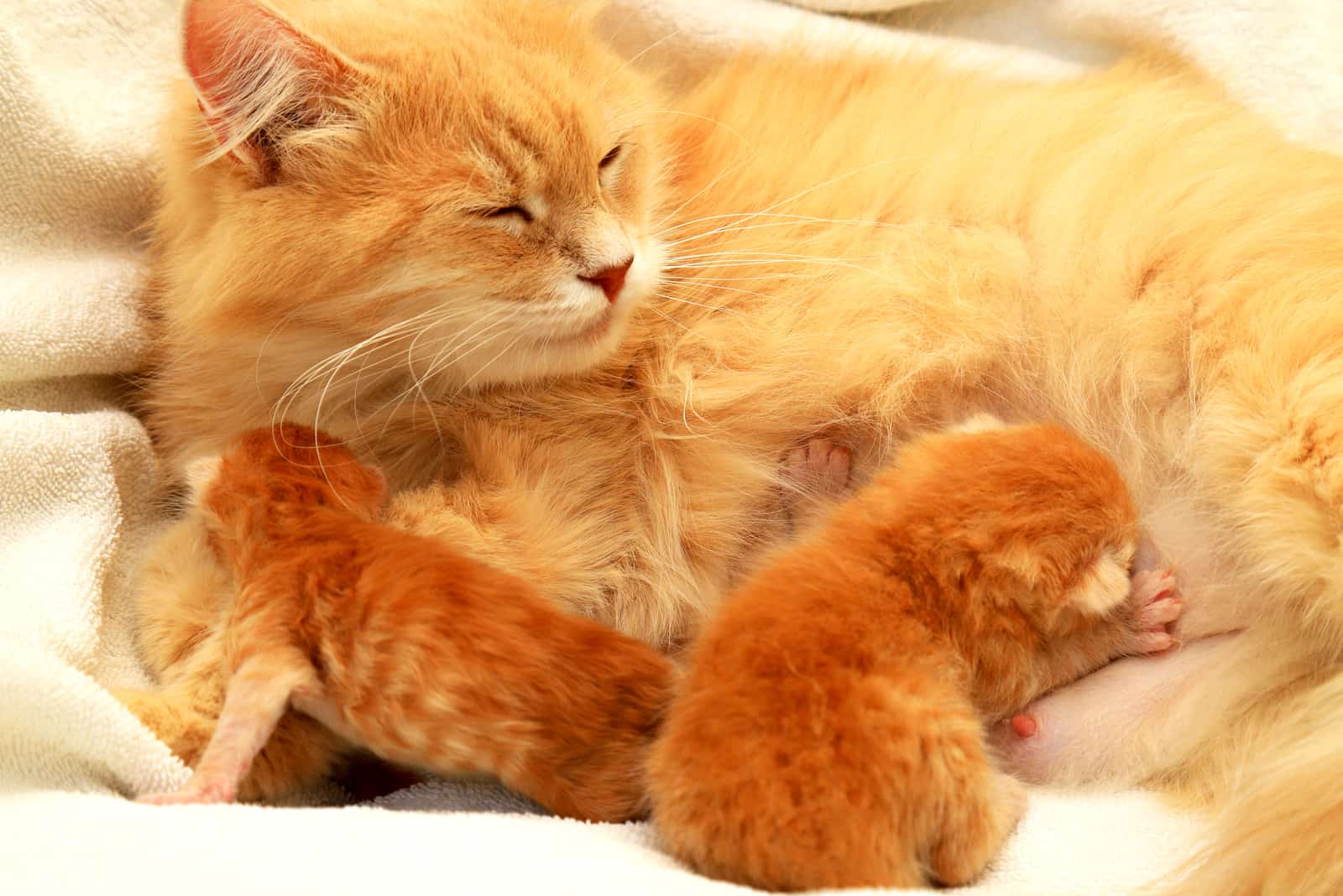
Your cat birthing kittens can be stressful, to say the least. No matter how many times you might have seen a cat in labor, it still is a bit nerve-wracking.
All cat owners want a happy outcome to their cat’s pregnancy, so a very important question arises: How to know when a cat is done giving birth?
The biggest tell-tale signs a cat is done giving birth are when the cat is not experiencing contractions anymore, is ceasing to strain to push a kitten out, and is beginning to calm down, get her breathing back to normal and focus on nursing her kittens.
There are a couple of other signs that the cat has given birth to all her kittens, but the above mentioned are the most obvious ones.
I know you just want everything to go well so that your kitty and new kittens are safe and healthy. Learning how to recognize when labor is over and – most importantly – when labor is not over, can mean a lot to your kitty’s health.
Continue reading to learn all about the end of cat labor!
How To Know When A Cat Is Done Giving Birth?

In order to fully grasp the topic of cat labor, let’s quickly go over the birthing process so that you know what to expect and how to recognize the end of labor is close.
A Quick Overview Of The 3 Stages Of Cat Labor
Cat labor occurs in 3 stages:
1. First Stage Of Cat Labor
The first stage of cat labor is characterized by the relaxation of the cervix and vagina, a drop in body temperature, as well as the start of contractions that will be invisible to the cat owner. Changes in a cat’s behavior are more noticeable, such as the cat becoming restless and refusing to eat.
2. Second Stage Of Cat Labor
The second stage of labor is characterized by the cat licking her vulva excessively, followed by active labor: strong and frequent contractions, straining, and the subsequent delivery of kittens.
3. Third Stage Of Cat Labor
The third stage of labor is characterized by delivering the placenta, or ‘after birth’. The placenta can come out with each kitten and the cat often eats it. Multiple placenta can be delivered at the same time as well. The cat will also bite off the umbilical cord after each kitten is born.
There are many other characteristics of all three stages, but these are the most important pieces of information you might need.
How Do I Know My Cat Is Done Giving Birth: 8 Signs
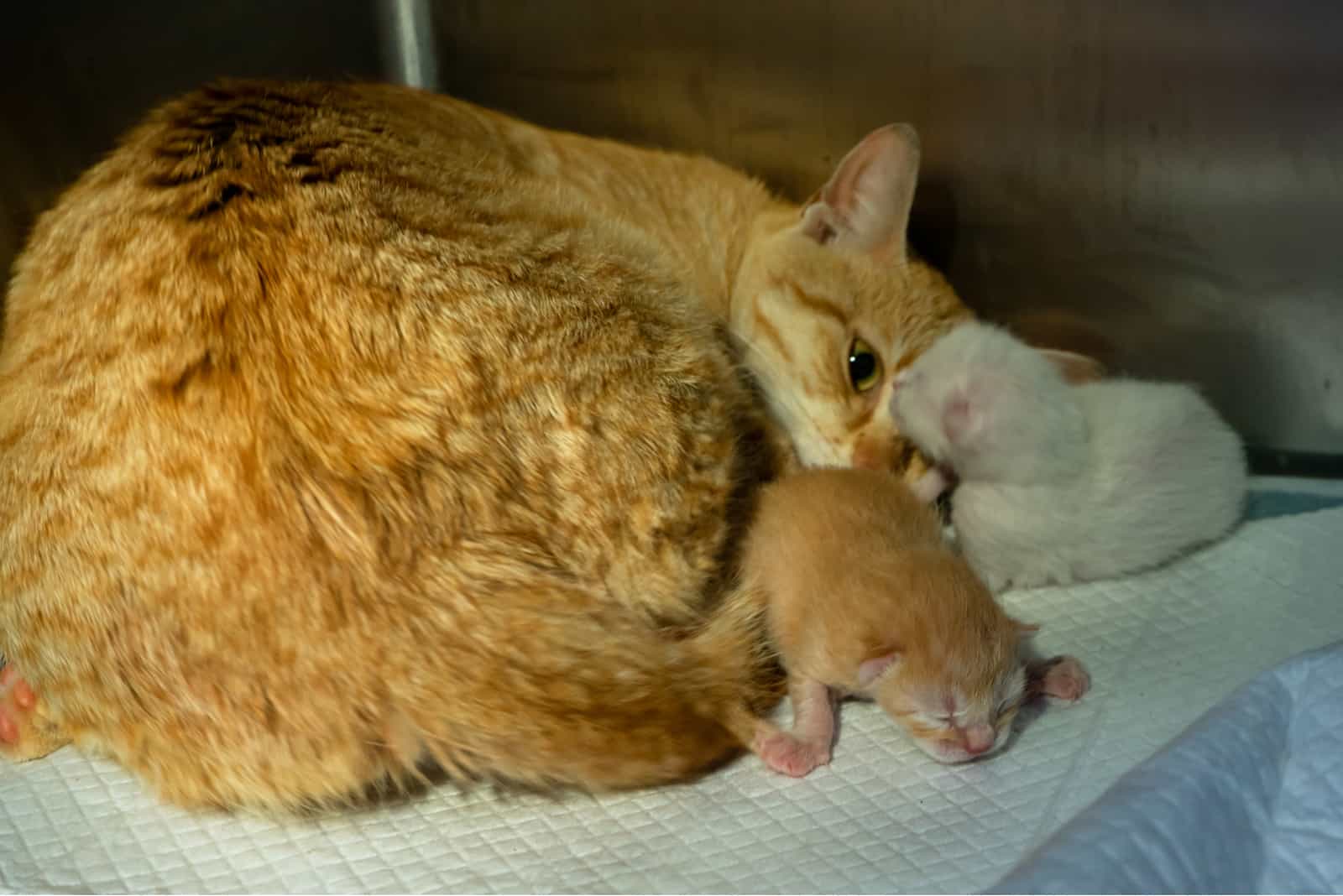
1. Not Experiencing Contractions
Contractions are the name for the uterine muscles tightening and relaxing periodically with the goal of pushing the kittens out through the birth canal. In order for labor to take place, contractions are absolutely necessary.
When the contractions stop, that’s the most likely sign that there are no more kittens to be pushed out.
You might be wondering What do cat contractions look like?
You will need to very gently press her abdomen to see if you feel anything. If your cat is still experiencing contractions, you will feel her abdomen tightening and relaxing. If the contractions are strong enough, it will also be visually observed.
It’s important to bear in mind that the contractions can stop if a cat is experiencing interrupted labor. This means that, for the time being, she’s not going to give birth to any more kittens, but labor will surely continue for a couple of hours or longer.
Also, if a cat stops having contractions and there are more kittens inside, that can be a serious issue. So, even if you feel no contractions, make sure that there’s no kittens inside her stomach. Do so by gently pressing her abdomen and feeling if there is something there.
2. Not Straining Anymore
If your cat has stopped straining, this might be an indication that labor has finished. It can also mean that the cat has finished giving birth… for now. In the case of interrupted labor, a cat will continue giving birth sometime later and will completely stop straining for some time.
Behavioral changes are very noticable when the cat is giving birth and when the cat is done giving birth. Not noticing specific cat behaviors such as straining, trying to find the “right position” and pushing, are strong signs that a cat is done giving birth.
As I already said, this might be a false sign that labor is finished, if a cat is experiencing interrupted labor.
3. A Cat Beginning To Calm Down
A very important sign of a cat in labor is her being restless and very vocal (of course – delivery is painful!).
If your cat is beginning to calm down, acting more relaxed and comfortable and has normalized her breathing, these are signs that labor has potentially ended.
You will observe this quite easily, and putting it together with some other signs that a cat has finished giving birth – you can be pretty sure that the job is done.
4. She’s Focused Only On Nursing Her Kittens
This is not a rule, but most cats usually wait for all their kittens to be delivered and then devote their entire attention to feeding them.
Of course, after each kitten is born, the mother cat will immediately start cleaning the kitten and nursing it. This duty does not take a long time, and then the cat is back to delivering any other kittens.
After all kittens have been delivered, the mother cat then devotes all her focus and attention on nursing her newborn kittens and providing kitten care.
If you notice this happening, know that it is not a 100% certain sign that cat labor has finished, but it is a likely sign that cat labor is over.
5. You Should Not Feel Anything In Her Abdomen
If you suspect there might be a kitten or two left to be delivered and your cat is not delivering them (yet), you can gently feel your cat’s abdomen.
Gently move your hand over your cat’s tummy to check if you can feel any “bumps” that are actually kittens in the womb.
If you notice a bump, it’s likely a kitten still inside and needing to be delivered.
6. The Cat Gave Birth To An Expected Number Of Kittens
If you’ve had your pregnant cat for an x-ray or ultrasound, you will know how many kittens to expect.
If your cat’s ultrasound showed that your kitty is carrying a certain number of kittens, you can expect that certain number of kittens to be delivered.
Of course, there might be a surprise of an extra kitten, but this is not very common as ultrasound and x-rays are pretty reliable.
What Is The Average Number Of Kittens A Cat Will Have?
If you’re expecting your cat to give birth soon, you might be wondering: How many babies can a cat have in the first place?
A cat can have anywhere from 1 to more than 10 kittens in one litter! The most commonly observed number of kittens in a litter is 3-6. Some cat breeds are known for having large litters, such as Oriental or Siamese cats.
Can A Cat Have Only One Kitten?
Yes, a cat can give birth to only one kitten. It is rather unusual and it does not happen often, but it is normal. It does not mean your cat is unhealthy or anything like that. A cat giving birth to one kitten is more commonly observed in first-time moms.
7. Might Be Tricky: The Last Placenta
After each kitten is born, the mother cat needs to deliver the placenta of that kitten and also bite off the umbilical cord.
Cats are known to eat the placenta after delivering a kitten, so don’t be surprised to see that happening. The placenta is full of nutrients that are great for your cat’s healthy development.
However, what you need to do is to keep an eye on the last placenta! After the last kitten, the last placenta needs to come out too!
Retained placenta, when the placenta is not delivered but stays inside the mother cat, can give rise to a number of health complications for your cat, so make sure the number of kittens equals the number of placentas.
This might be tricky. After all, what if a placenta comes out, but there is still another kitten on the way?
For this reason, delivering the placenta is only a good indicator a cat has finished labor if it’s indeed from the last kitten!
Please keep this in mind, as it is very important.
How Long Does Cat Birth Last?
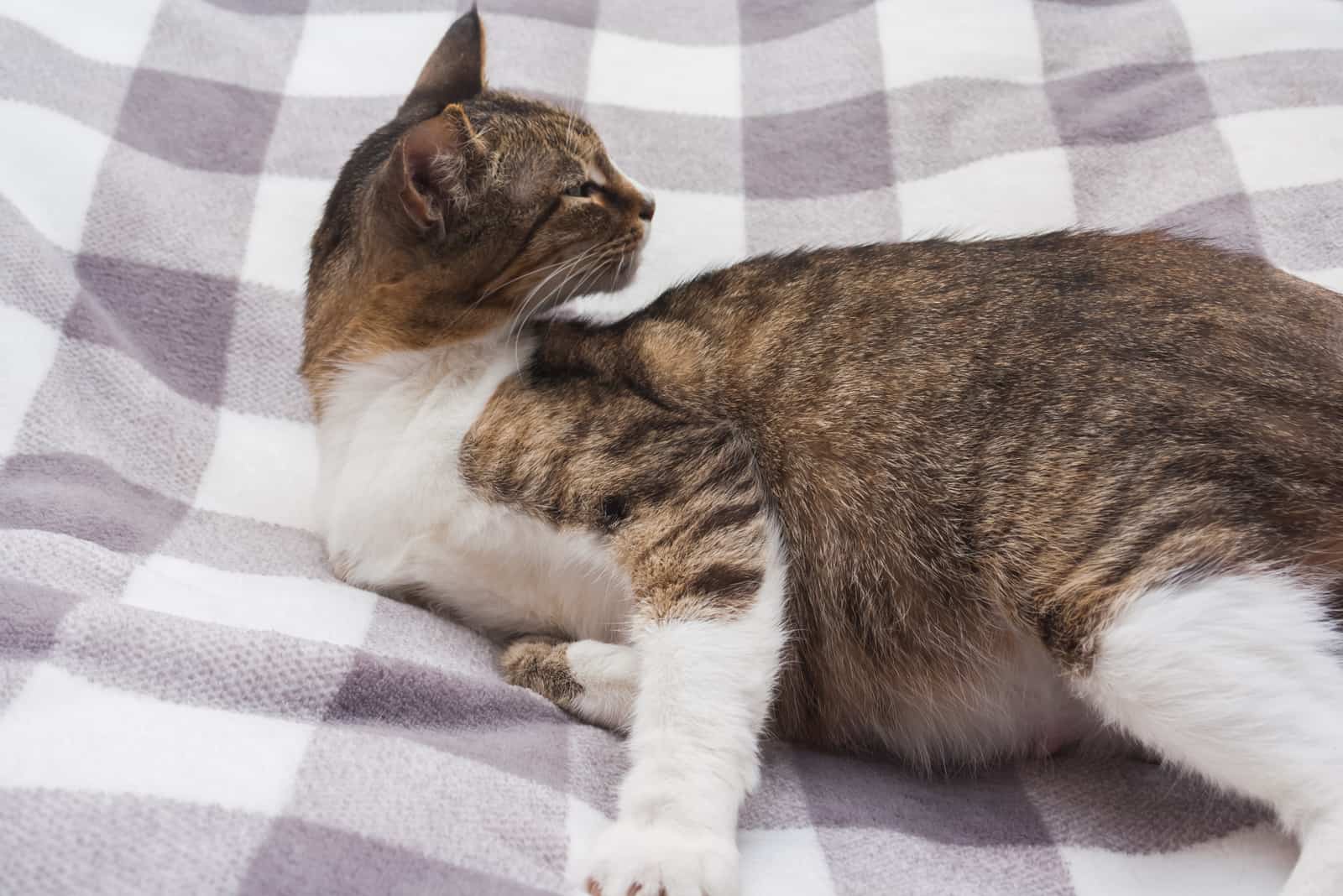
The first stage of cat labor (where no kittens are coming out yet), lasts usually from 6 hours to a day before the actual delivery of kittens. It can last even longer if it is the cat’s first litter.
The second stage of labor, where the kittens are actually delivered, can last anywhere from 2-12 or even 24 hours. It’s important for the first kitten to arrive from when the strong contractions begin and up to 2 hours after.
The kittens then come in 30-60 minutes intervals, but interrupted labor in cats is a possibility. This is when a cat gives birth to a few kittens, then rests for a few hours, and then continues delivering the remaining kittens.
What Happens When A Cat Is Done Giving Birth?
Your cat has given birth to a litter of kittens… now? What can you do after a cat gives birth?
The best thing to do is – do nothing! The mother cat will do everything she needs to do in order to keep them safe. Her powerful instincts guide her and there is no need for you to help in any way unless you think she is unwell.
Let the cat and her kittens have their space, provide plenty of food for the mother cat and keep an eye on her health – are there any signs she’s not feeling the best?
Other than that, don’t intervene at all. This doesn’t mean you should avoid being near them at all, actually – your presence might be calming for the mother cat. Just don’t overdo it.
How Can You Help A Cat After Labor?
You might not expect this, but post-labor cat care is very straightforward and simple. As a pet parent, you might be eager to do everything you can – but there are only a few things you should actually do.
Let’s put all the advice into a list:
🐾 Don’t invade your cat’s space. A mother cat does not like this as she only wants to be with her kittens.
🐾 Keep an eye on them if you become needed for some reason. For example, due to a health complication – it’s important you recognize it’s happening so you can help.
🐾 Make sure the mother cat eats but don’t push her. She most probably will not want to eat until she is ready, so just put some food and water nearby. She does need to eat in order to regain energy, but she will know when the time is right by herself.
🐾 Check once in a while to see if the cat is caring for the kittens properly, that they are all being fed and no kittens are being rejected (this is a possibility).
When Should You Worry?
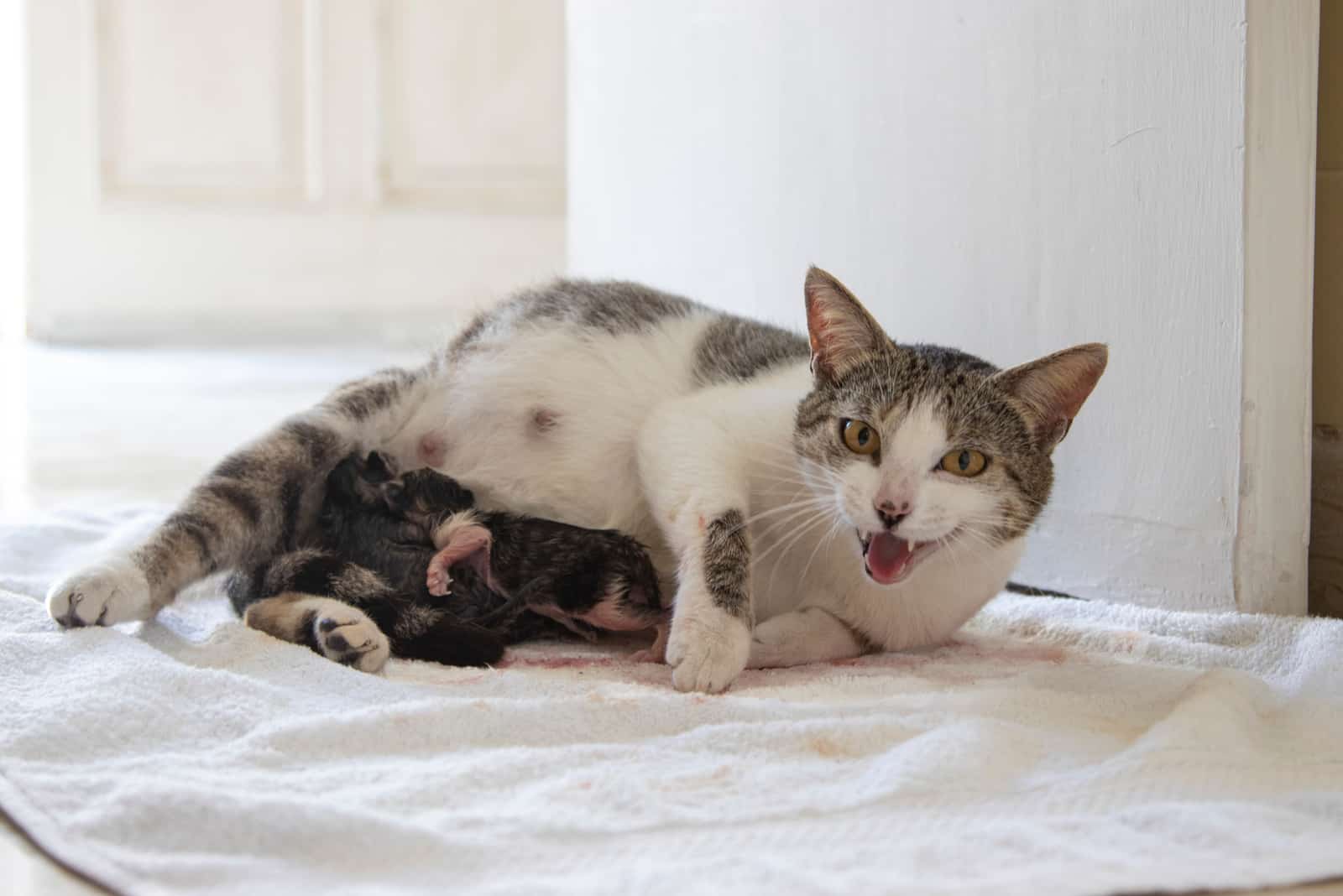
All pet parents want a normal and natural labor for their pets. It’s important to say that most cats have a completely normal labor and experience no issues. However, sometimes, that is not the case and complications can arise. Dystocia is a name for a complicated kitten delivery. It may encompass a lot of different symptoms.
If you notice the following signs, this is an indication something is wrong:
🐾 Cat experiencing strong contractions for a long time without delivering the first kitten.
🐾 Cat experiencing weak (or no) contractions, but you know other kittens still need to be delivered.
🐾 If you observe a kitten that is stuck in the birth canal.
🐾 Cat’s abdomen swelling.
🐾 Only one side of the uterus contains all kittens.
🐾 Cat being overly anxious, restless, and uncomfortable (extreme distress or more anxiety than you would expect).
🐾 Having a very painful and long labor.
🐾 Cat being extremely tired and lethargic, failing to respond to you.
🐾 Cat experiencing vaginal bleeding.
🐾 Cat losing consciousness.
🐾 Cat not expelling the placenta after a kitten’s birth.
🐾 Cat vomiting and not eating.
What Should You Do?
If you observe any of these symptoms, veterinary assistance is needed! If you ignore any of these symptoms, it can end very badly for the cat and possibly the kittens that are still left inside her! So please, pay attention to your cat’s behavior and if you notice anything abnormal, get help.
Potential Health Issues That Can Arise After Labor
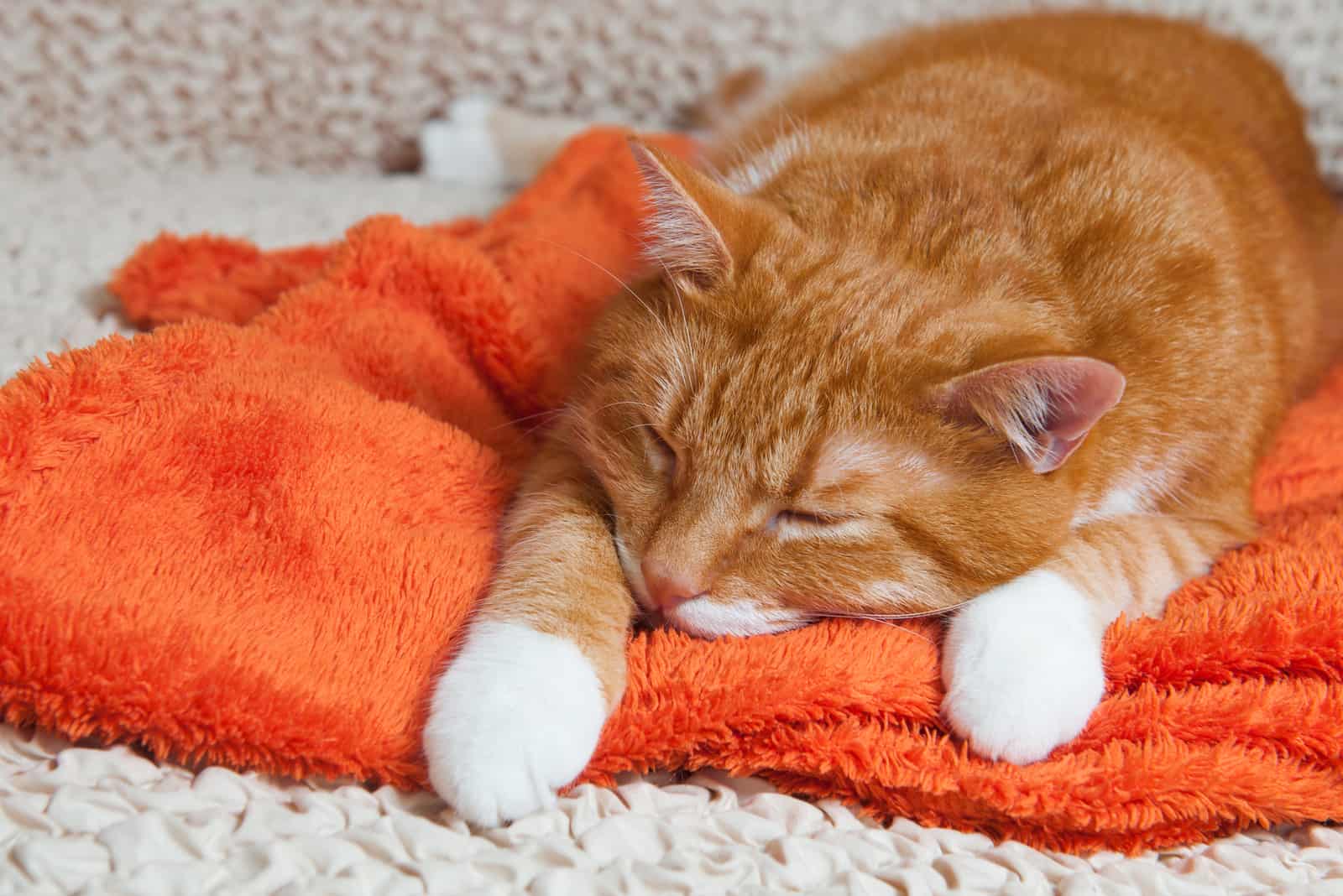
Apart from symptoms associated with dystocia, what are some known health issues that can arise during and after labor?
I recommend all cat owners do a little bit of research about potential health issues that can occur after labor. It is good to know what the tell-tale symptoms of certain health problems are, so if they arise, you can notice them early.
Below are a couple of the most common issues that mother cats experience after birth and during nursing.
Metritis
Uterus inflammation, known as metritis, is a condition which develops after kitten delivery. It does not develop immediately, but rather a few days after delivery. It is caused by bacteria (such as E. Coli), and the most prominent symptoms are a swollen tummy and abnormal vaginal discharge.
What Could Be The Cause Of Metritis?
🐾 Giving birth in an unsanitary conditions (on a dirty floor for example)
🐾 Not delivering the placenta fully
🐾 Hard delivery, especially with large litters
Symptoms Of Metritis:
🐾 Foul-smelling vaginal discharge
🐾 Swollen abdomen
🐾 Dehydration
🐾 Fever and lack of appetite
What Should You Do?
You need to visit the veterinary office. Depending on the severity of the inflammation, your cat might need to be hospitalized. Antibiotics are used to treat bacterial infections, so you can expect your cat to be prescribed a course of these. This may mean that nursing her kittens is not an option since some antibiotics are not safe for kittens and they pass through the mother’s milk.
Mastitis
In the case of mastitis, milk ducts may carry a bacterial infection, which can be extremely painful to the cat. It can happen in only one or in several of the cat’s teats.
Mammary glands have the job of producing milk that is necessary for kittens. Mastitis can make the mammary glands blocked, preventing milk from being released. This naturally makes the cat unable to feed her kittens.
Apart from the inability to provide for her kittens, it is also very painful and uncomfortable for the cat. Her teats become swollen, red, and very sensitive to touch. Pus may come out of them and that is never a good sign.
Symptoms Of Mastitis:
🐾 Swollen teat(s)
🐾 Red and inflamed teat(s)
🐾 Loss of appetite
🐾 Fever and overall weakness
What Should You Do?
You should visit the vet if you suspect your cat has mastitis. If indeed mastitis is diagnosed, antibiotics are the most likely prescribed treatment.
Eclampsia
As you already know, calcium is an important mineral that has many important functions. It is crucial to have a sufficient amount of calcium in blood, in order to keep the body running. Having low calcium levels is known as hypocalcemia and when this condition arises very suddenly, this is called eclampsia.
Essentially, all the calcium from your cat’s blood suddenly goes to the cat’s milk. This leaves the cat with a minimal level of calcium in her blood, which can be deadly.
Symptoms Of Eclampsia:
🐾 Aggressive behavior
🐾 Pacing and being restless
🐾 Fever
🐾 Disorientation
🐾 Muscle spasms and convulsions
What Should You Do?
You need to go to a doctor of veterinary medicine (VM) as soon as possible! If not treated on time, this can be deadly. Time is of the essence here!
Frequently Asked Questions

How Do You Know A Cat Is Done Giving Birth?
The following signs are an indication that a cat is done giving birth:
🐾 Not experiencing contractions anymore
🐾 Not straining anymore
🐾 Beginning to calm down
🐾 Starting to nurse her kittens devotedly
🐾 Not feeling any lumps when touching her abdomen
🐾 Cat giving birth to the expected number of kittens (if you had an ultrasound beforehand)
🐾 Cat has pushed the last placenta out
🐾 Cat has bitten off the last umbilical cord
How To Tell If A Cat Still Has Kittens Inside?
This are the signs your cat still has kittens inside:
🐾 Still experiencing contractions
🐾 Still straining, trying to push the kitten/ kittens out
🐾 Licking the genitalia
🐾 Not nursing her kittens yet
🐾 You can feel something (lumps) in her abdomen
How Long Does It Take For A Cat To Finish Giving Birth?
Before the actual delivery, the cat’s pre-labor period can last from 6 hours to more than a day. The actual act of birthing kittens can last anywhere from 2-12 hours, or even 24 hours.
What Is The Average Gestation Period Of A Cat?
You can expect the average cat pregnancy to last around 60-65 days, give or take a few days. This translates into about 8 or9 weeks, or 2 months.
What Do I Need To Do If My Cat Is Not Finished Giving Birth?
If your cat is still giving birth to kittens, there isn’t anything you can do. Your cat will manage it all on her own. You just need to observe any signs that something might be wrong, for example your cat having contractions but not delivering kittens, your cat suddenly becoming weak, etc.
If you observe something is wrong while your cat is giving birth, or after she’s done giving birth – you either need to bring your cat to the vet, or have a vet come to you.
What Should I Do If My Cat Is Still Giving Birth After A Day?
Even though it’s common for kittens to be born many hours apart – there is still a reasonable time limit. If your cat gave birth to the last kitten a relatively long time ago, and you know more kittens are on the way – I recommend visiting the vet.
It could be nothing – your cat may simply be having a large time period of not giving birth. But it can also mean something might be wrong, so the safest bet is visiting the vet.
In Conclusion
Cat pregnancy and delivery is a reason for joy but also a little bit of stress. Everyone just wants the delivery to go smoothly and for the cat, and her kittens, to be healthy.
Many cat owners know the signs of pre-labor, but knowing when the labor has actually ended might be a bit tricky.
This is how to know when your cat is done giving birth: contractions have ceased, straining is no longer observed, the cat’s breathing is back to normal, she’s started nursing her kittens devotedly and she has given birth to the expected number of kittens!
Keep a watchful eye on your cat during and after labor in order to be 100% your cat’s health is good. Cats usually cope perfectly well with delivery but several things can go wrong, so it is important that signs are spotted on time.
Luckily, cats are not known for having complicated labors, so don’t worry too much! Now go – you have a litter of kittens to enjoy!
Related Articles:
Why Do Female Cats Attack Males After Mating? Learn Now


